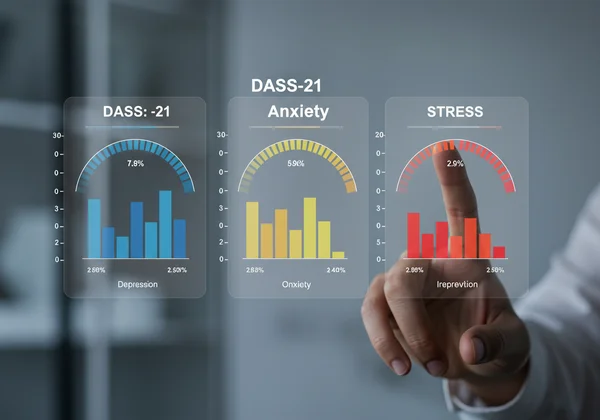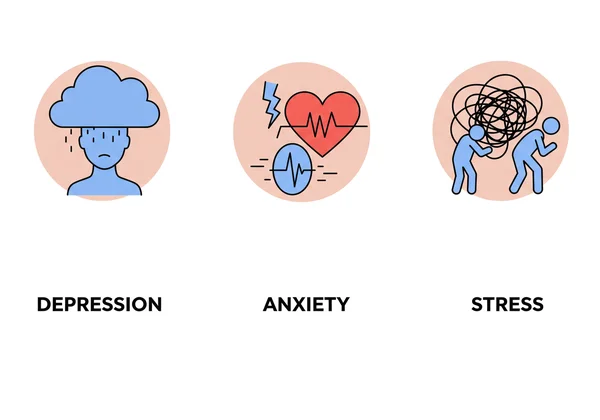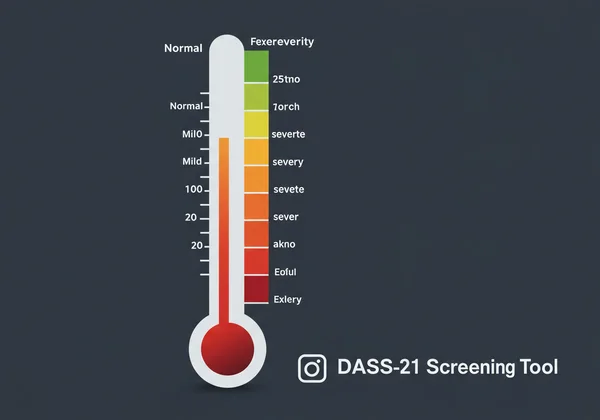DASS-21 分数:严重程度评级全指南
花点时间检查一下自己的情绪健康,这是一个有力的第一步。你已经回答了问题,现在你面前有一组数字。这自然会引出最重要的问题:我的 DASS-21 分数到底意味着什么? 理解你的结果不仅仅是看数字;更是为了让你清晰地认识到自己目前的情绪状态。本指南将引导你了解 DASS-21 严重程度评级的各个级别,将你的分数从抽象的数字转化为有意义的洞察。
如果你还没有进行评估,或者希望随着时间追踪你的分数,你可以随时在我们首页 进行免费评估。本指南将在你准备好时,帮助你理解你的结果。
你的 DASS-21 分数意味着什么?
抑郁、焦虑和压力量表 (DASS-21) 是一种旨在衡量一系列症状严重程度的自我评估工具。你的结果被分解为三个不同的方面,这比单一的、笼统的分数能给你更清晰的图景。这是你过去一周情绪体验的快照。

三个维度:抑郁、焦虑和压力子量表
理解 DASS-21 提供三个独立分数至关重要。每个分数对应一套不同的情绪和身体症状,从而让你对自己的健康状况有更细致的了解。这种区分有助于你确定哪个特定领域可能给你带来最大的困扰。
- 抑郁量表: 该子量表评估诸如情绪低落、缺乏兴趣或乐趣、感到毫无价值和绝望等症状。它衡量你的自卑程度以及无法体验快乐的情况。
- 焦虑量表: 该子量表侧重于生理反应的症状,例如心跳加速或手发抖,以及恐惧和恐慌的主观感受。它描述了人们感到“精神紧张”或“极度不安”时的体验。
- 压力量表: 该子量表评估神经紧张、易怒和难以放松的感觉。它反映了一种持续的过度激惹状态,以及容易变得激动或沮丧的低阈值。
通过单独查看这些 DASS-21 子量表,你可以更好地精确定位你情绪困扰的性质。

理解原始分数与严重程度类别
完成 21 个问题的评估后,系统会计算出三个子量表的原始分数。为了让这些数字更容易理解,然后会将它们与既定的阈值进行比较,从而归入五个严重程度类别之一。这个 DASS-21 分数解读 的过程是将一个数字转化为一个实用的标签。
这些类别从“正常”到“极重度”。这个分类系统旨在帮助你快速评估症状的强度。重要的是要记住,这些不是永久性的标签,而是你近期经历的反映。这个框架提供了一种清晰且标准化的方式来 理解你的分数。
DASS-21 严重程度评级详解:从正常到极重度
让我们深入了解你的结果核心。抑郁、焦虑和压力的五种严重程度评级中的每一种都有其特定含义。了解每个级别代表的意义,可以让你有能力采取适当的下一步行动,无论是保持健康习惯还是寻求额外支持。
正常分数:平衡状态的样子
获得“正常”范围内的分数,表明你在过去一周经历的症状在典型和健康的范围内。这表明你在应对生活挑战时,在该特定区域没有显著的情绪困扰。一个 正常的 DASS-21 分数 是情绪韧性和有效应对机制的积极信号。它反映了一种情绪平衡状态,让你能够处理日常任务和人际关系,而不会被悲伤、担忧或紧张的情绪过度负担。
轻度和中度级别:识别早期信号
属于“轻度”或“中度”类别的分数,是温和的提醒。它们表明你正在经历可察觉的抑郁、焦虑或压力症状,这些症状在某种程度上影响着你的日常生活。这些级别是关注你心理健康的重要信号。
“轻度”分数可能意味着你有一些“不顺心”的日子,比平时更担心,或者发现自己更难放松。 “中度”分数表明这些症状更持久,并可能干扰你的工作、学习或社交生活。认识到这些早期迹象,例如 轻度焦虑 或 中度压力,是一个主动采取行动的机会。这可能包括重新评估你的自我关怀习惯、与信任的朋友交谈,或探索压力管理技巧。
重度和极重度:何时寻求专业支持
如果你的结果处于“重度”或“极重度”范围,这是一个强烈的信号,表明你的症状正在引起显著的痛苦,并且可能对你日常功能产生重大影响。例如,一个 重度焦虑分数 表明情绪动荡的程度会让人感到难以承受,难以独自应对。
至关重要的是,要将这些分数视为寻求专业帮助的明确且有说服力的理由,而不是恐慌的原因。与医生、治疗师或咨询师交谈是至关重要的下一步。这些专业人士可以提供正式的诊断、制定个性化的支持计划,并引导你接受有效的治疗。寻求 针对抑郁症状的专业帮助 或其他得分较高的领域,是力量的体现,也是你能为自己的健康采取的最重要行动。

为何准确解读对你的健康至关重要
理解你的 DASS-21 分数,不仅仅是一项学术练习;它是迈向自我认知和积极改变的第一步。准确的解读赋予你对自己的心理健康之旅做出明智决定的力量。
DASS-21 作为一个工具,而非诊断
这也许是最关键的一点需要记住:DASS-21 是一个筛查工具,而不是诊断工具。它的目的是衡量症状的严重程度,并为你提供一个个人基准。它不能告诉你为什么你感觉这样,也不能明确地说你患有临床疾病。
正式诊断只能由合格的医疗专业人员在进行全面评估后做出。将你的 DASS-21 结果视为你情绪健康的温度计——它告诉你是否“发烧”,但它不会诊断潜在的疾病。将其视为自我反思的指南,是使用这一宝贵资源的最有效方式。你随时可以稍后 获取你的结果 以追踪你的进展。

获得分数后的下一步
你的结果是采取行动的起点。如果你的分数处于正常或轻度范围,请思考你做得对的地方以及如何继续支持你的健康。这可能包括正念练习、体育锻炼或与亲人联系。
如果你的分数是中度、重度或极重度,你的首要下一步应该是与医疗专业人士分享这些结果。他们可以提供背景信息、支持和基于证据的策略来帮助你感觉更好。你可以将你的结果作为谈话的起点,提供关于你经历的具体数据。这些知识使你能够为自己的健康代言,并开始改进的道路。
展望未来:利用你的 DASS-21 洞察
理解你的 DASS-21 分数,就是一种赋权行为。它让你清晰、客观地审视自己的情绪健康,将模糊的感觉转化为具体的信息。通过了解不同严重程度的评级含义,你可以更好地驾驭内心的世界,并做出支持你健康的决定。请记住,这些分数不是最终的审判,而是帮助你踏上旅程的指南。
无论你的结果是鼓励你保持当前的生活方式,还是激励你寻求支持,你都迈出了走向自我认知的重要一步。要开始你的自我发现之旅,或随着时间推移监测你的情绪健康,请 访问我们的首页 进行免费、保密的 DASS-21 评估。
关于 DASS-21 分数的疑问解答
什么是 DASS-21 的正常分数? “正常”范围内的分数表明,你报告的抑郁、焦虑和压力症状处于健康、典型的水平。这表明你能够应对生活中的挑战,而没有显著的情绪困扰。
如何解读 DASS-21 三个量表的分数? 解读包括独立查看抑郁、焦虑和压力这三个量表的严重程度评级(正常、轻度、中度、重度、极重度)。这有助于你确定自己情绪健康的哪个特定领域可能需要最多的关注。
DASS-21 是一个诊断工具吗? 不是。DASS-21 是一个高度可靠的筛查工具,用于测量症状的严重程度。它是自我评估和与医疗保健提供者开启对话的绝佳资源,但它无法提供临床诊断。
什么是 DASS-21 严重程度评级? DASS-21 使用五种严重程度评级来对每个子量表的分数进行分类:正常、轻度、中度、重度、极重度。这些类别有助于使你的数值分数更易于理解和操作。
获得高 DASS-21 分数后该怎么办? 高分(处于重度或极重度范围)是一个强烈信号,表明你应该寻求合格专业人士(如医生、治疗师或咨询师)的支持。他们可以提供适当的评估,并引导你获得有效的支持和治疗。采取这一步对你的健康至关重要,你随时可以 开始你的自我评估 以在预约前收集信息。